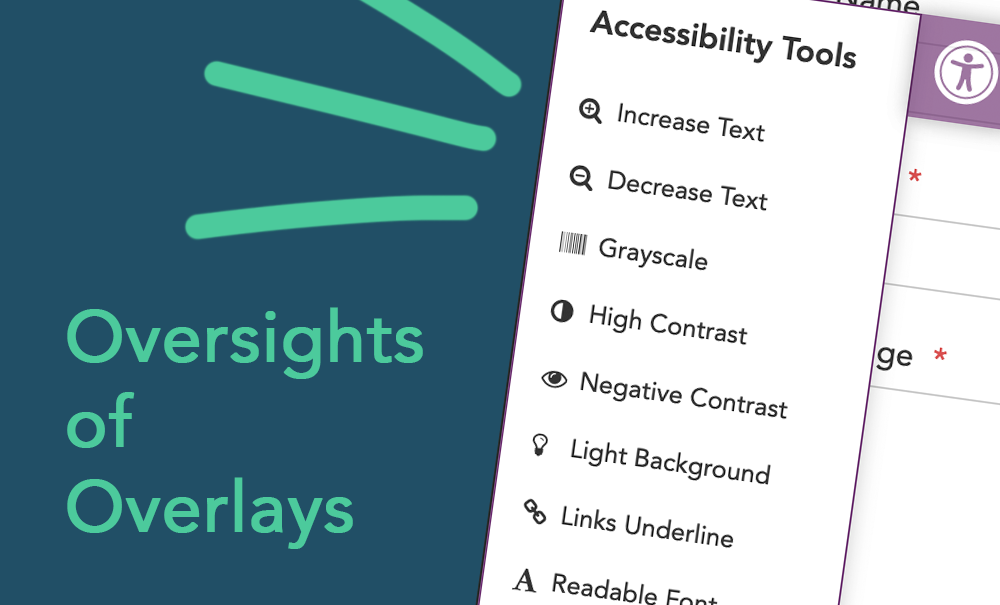The Oversights of Overlays

 Making sure people with disabilities can easily use your website takes time and effort. You need to inspect various parts of the site and consider a range of people's needs. You want to make sure all of your site is accessible.
Making sure people with disabilities can easily use your website takes time and effort. You need to inspect various parts of the site and consider a range of people's needs. You want to make sure all of your site is accessible.
When a big task needs doing, salespeople often pop up with their quick and easy solution to get the job done. The ever-tempting, one-size-fits-all method of creating an accessible website comes in the form of the "accessibility overlay". Salespeople will tell you that an accessibility overlay is a simple, low-cost way to get a website fully accessible. Well, that sounds great, doesn't it?
Unfortunately, automating a difficult task often has its problems. For some things, there is no easy, quick fix. Before you decide on an accessibility overlay, it's best to take a good look at what this technology can and can't do.
What is an Accessibility Overlay?
In short, an accessibility overlay is a program that you can add to your website. The program design alters a website based on the needs of the user. Adding an accessibility overlay to your site doesn't require you to change the code of your website or purposefully install it. Most overlays only need a few lines of JavaScript to start working.
Website users will often see the added accessibility information in the form of a drop-down menu. Options will be available, such as:
- font size and colour changes
- text-reading choices
- navigation help, and a few others.
In theory, the user can click an option, and the overlay changes the site to meet the user's needs.
It all sounds good so far. Who wouldn't want a simple accessibility overlay to create a wide variety of accessibility options on their website?
Sadly, simple solutions typically don't work for complex issues like website accessibility. Accessibility overlays incorporate minimalist design. Their one-size-fits-all approach is supposed to meet the needs of all people with disabilities. Fundamentally, this is a problem.
Accessibility Overlays Can't Do Everything
An overlay relies on automation. It uses artificial intelligence and computer programs to try to predict people's needs. A computer program can only do so much. If the program can't find what it needs to operate on a website, it won't work.
The website https://overlaysdontwork.com/ by Karl Groves shows several different examples of website code that often doesn't work with accessibility overlays. Each website design is individual, but yet the overlay is not custom-fit.
Accessibility Overlays Can Make Websites Less Accessible
Overlays aren't just ineffective at providing accessibility options. They can actually make your website less accessible. Many people with disabilities use accessibility equipment to access the Internet. For example, people with visual disabilities may use screen readers. When a website has an overlay, it can impact the functionality of the screen reader. Your website user will be frustrated and will probably leave your site.
Site users with disabilities might have to give up on how they usually would access the site and be forced to use the overlay instead. As explained earlier, the overlay will most likely fail to help the user in the way that they need support. The equipment and programs that users with disabilities already use are much more robust than any overlay. Accessibility equipment and programs meet the specific needs of the individual. The simple, all-purpose functionality of an overlay won't meet most people's needs.
Overlays Don't Achieve AODA Compliance
The Accessibility for Ontarians with Disabilities Act (AODA) outlines how a website should be accessible. You can test your website to see if it meets the expectations of the law. What you receive after the test is a "compliance report" that tells you if your site is accessible or not and how to fix it if it is not. These reports are crucial to avoid getting into legal trouble because of an inaccessible website. You may find out your website needs to be fixed and panic. After all, it is against the law in Ontario and many countries to have an inaccessible website. You may turn to overlays to get your website compliant quickly. Unfortunately, by using an accessibility overlay, you will almost certainly not pass your compliance report. The basic functionality of overlays does not cover what is needed to be compliant. The weaknesses of overlays are well understood by those who will review your website. You can trace many lawsuits regarding website inaccessibility back to ineffective overlays. Salespeople may tell you these overlays will get you compliant with government standards. The fact is, you're going to need more than a couple of lines of code put into your site to fix any accessibility issues on your website.
Overlay Overview
So-called accessibility overlays are most often ineffective and unreliable for people with disabilities. These overlays are generally best to avoid. Accessibility is no simple task, so always be wary of services that seem to promise a lot for a little. Be sure that your accessibility service provider gives you a comprehensive audit and a thorough site redesign if needed. Don't be fooled by cheap and easy website accessibility "solutions". They don't exist.
Accessibrand is an accessibility-focused collective of design, marketing, and communications professionals who want to help businesses create a more disability-focused future. We're an agency that knows how to make materials accessible because we see the world from a disability perspective. For website audits and other accessibility needs, contact jolene@accessibrand.com.
| COMMENT | ADD A COMMENT |
